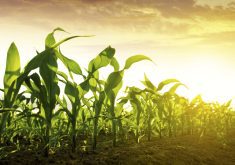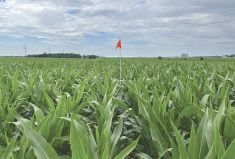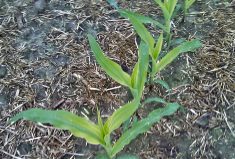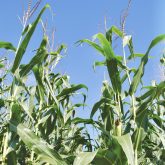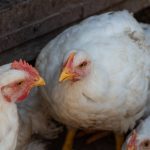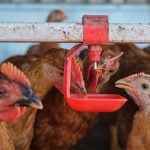It’s easy enough to get pessimistic about corn these days. Just look at Chicago prices, or look at all the news reports from all around the world about the tremendous corn production potential of everywhere from Brazil to Ukraine.
Or you could look closer to home, and get a dose of optimism.
That’s what Ken Nixon is doing from his farm at Ilderton, just north of London, Ont. Nixon agrees there’s a lot of history working against mainstream crops, especially corn. Farming in an economic climate of $3.70 corn is a troubling reality, he concedes, especially coming off $7 and $8 corn for the better part of a year.
Read Also

Could crop sharing be a viable option for your farm?
Crop sharing could be a good option for young and beginning farmers.
But instead of complete despair, Nixon sees hope and opportunity, particularly when he looks at what happened to Ontario’s soybean and wheat sectors over the past 20 years when they faced similarly bleak prospects.
Visionaries including Peter Hannam of Woodrill Farms at Guelph helped blaze a trail for value-added, identity-preserved soybeans, Nixon points out, and through their tireless work, Canada has earned a quality-based reputation and strong premiums for its food-grade soybeans.
Much the same process has evolved for Ontario wheat, says Nixon, who as a director on the Ontario Wheat Producers Marketing Board during the 1990s helped chart the sector’s transition out of mandatory pooling into an open market.
It was only 15 years ago that Ontario’s wheat acreage was 95 per cent soft white, Nixon points out. “We went from a completely soft white winter scenario and we diversified into hard red springs, hard red winters and soft reds.”
There was lots of doom and gloom, Nixon recalls. Millers and bakers — and more than a few farmers — thought that as soon as the U.S. noticed the new competition coming out of Ontario, they’d turn their competitive guns against us and it would be all over.
“Exactly the opposite happened,” says Nixon.
Now, the wheat sector in Ontario has diversified and strengthened, and today, Ontario’s mills grind nearly three times more wheat than they did in the 1990s, with a lineup that includes more bread flour than pastry, and a small durum market as well.
Says Nixon, “We’ve gone from a vanilla, one-wheat system — saying, ‘This is what we grow, and the markets will fill it for us,’ — to diversifying our production into something closer to what the market actually needs.”
Now there’s a growing consensus that eastern Canadian farmers need to take charge of their own corn future.
Or does anyone really believe it’s practical to think of shifting Ontario’s 2-1/2 million acres of corn into sweet potatoes, quinoa and oats?
- More Country Guide: Is corn losing the acreage battle?
Corn drives everything
Al Mussell believes it’s impossible to overlook or replace corn. The crop is too big and too powerful, both on a continental and a global basis.
“It all comes back to corn,” says Mussell, senior research associate at the George Morris Centre in Guelph. “In the West, some farmers will use corn futures as their benchmark or hedging instrument rather than barley futures, and they have for years. It’s hard to overstate how ubiquitous corn is.”
Besides, corn is the world’s feedstock, and with the rapidly expanding middle classes in China and India demanding more and more meat, that’s enough to assure corn a future market.
Plus, corn has another huge advantage. It’s simple, Mussell says. It’s “just” No. 2, yellow dent corn — and it can be used to produce quality protein products on a greater scale than any other crop.
“We’re going to have a lot more production, but on the other hand, we believe we’re going to need a lot more,” says Mussell.
Mussell sees no reason to worry about Ontario growers struggling to survive in a market oversupplied by corn grown in Ukraine, South America — or even Western Canada.
But he does have some concerns about the scale of Ontario production, and the price of land. It’ll be tough to compete on a volume basis with a state like Iowa, which grows 14 million acres of corn, he predicts.
“Iowa is a global player in the market — we are not,” Mussell says. “We’ve got areas that grow corn just as well as Iowa does, they’re just not as big.”
Ontario will never have the economy of scale of Iowa, Nebraska or Illinois, Mussell says. “So the question you ask then is, if you’re a bit player in the corn market, where do you play?”
The other issue is the spiralling value of land in Ontario. “It will have the effect of decreasing a farmer’s flexibility and their willingness to try new things,” says Mussell. “You worry about this in the context of the potential for five- to 10-million acres of grain corn in Western Canada in the next 10 years.”
Economics and management
Grain industry insider Martin Harry believes agriculture has been stuck in a “one-year memory situation” for too long, so the immediate outlook is all that seems to matter.
“It’s going to be different this winter compared to last,” says Harry, eastern marketing manager for SeCan. “Farmers aren’t flush with money the same way because we do not have $7 corn. In our business, it’s a knee-jerk reaction and we’re always a year late. Nobody grows a lot of seed because last year, nobody wanted it; next year, everybody will want it and we won’t have enough.”
Spring will be different too, Harry says. Already there are predictions that the U.S. will boost its soybean acreage, which could be bullish for corn.
Other farmers will look at other options, Harry also believes. He points, for instance, at the call a SeCan dealer in eastern Ontario got from a southwestern farmer this fall who couldn’t get his wheat planted because of wet ground. “They want to put in March oats,” Harry says. “If they (farmers) can’t make it in corn or soybeans, they’re going to look at other options. We’re going to see white beans and coloured beans at higher prices per pound, and with the harvest conditions, you may see a lot more dry beans. We’re going to see a lot more IP soybeans at $3 premiums — and we have varieties that are sold out already.”
Meanwhile, Larry Martin, principal of Agri-Food Management Excellence, watches how crops are marketed, and he sees much the same mindset that existed years ago, when the price of corn was barely above cost of production. Farmers don’t always react when the market provides an opportunity.
Farmers across the country wish they had locked in their grain and oilseed prices last spring. More to the point, however, if you suggest to Martin that the downturn in commodity prices means more farmers will invest in building processing and manufacturing facilities instead of growing corn or soybeans, you’ll be met with a healthy measure of doubt.
“I think it would be fantastic to do that, but I’m not sure that mindset is going to come around in my lifetime,” says Martin. “That’s exactly what we should be doing.
“For most of the last 15 years, we haven’t not even invested in the processing industry at the same rate as depreciation,” Martin says. “You have to have economies of scale — that goes hand in hand with the market access, and you have to replace labour with capital — you have to have high technology. Therefore you have to invest a little bit more than depreciation, and we’re just not doing it.”
Shifting the mindset
For Gord Surgeoner, in the midst of all the talk about shifting volume production to more value-oriented farming, the danger is that we often lose sight of the opportunities. The notion that “corn is corn” and that it’s suitable only for feed, high-fructose corn syrup and ethanol means that we’re ignoring huge possibilities.
“If you look at what we grow, it’s the feed side of the equation,” says Surgeoner, president of Ontario Agri-Food Technologies in Guelph. But to Surgeoner, everything can be changed. We can grow new kinds of corn that make better feed, we can breed livestock that will produce specialty meats and other products, or we can produce whole new classes of industrial or consumer products from corn.
Surgeoner attended the Ontario Economic Summit in October 2013, and was intrigued by Ontario Premier Kathleen Wynn’s challenge to provincial agriculture. By 2020, Ontario is anticipating the addition of 120,000 new jobs as well as a doubling of the export rate of growth and the evolution of the way that value is increased. From Surgeoner’s vantage point, that means we’ll have to go beyond being the growers of food, fuel and fibre, and become sellers of a process as much as a raw material or a product.
“By 2020, we’re going to have these measures in place, and a lot of what we’re going to do in science is for our food industry,” says Surgeoner. “We’re going to automate it, make it more efficient, with better information technology and reduce our labour inputs so that we can compete globally.”
It becomes a model not just for a value-added service, but recognition of the knowledge that goes with it. If we come up with solutions relating to food or energy processing, there’s a good chance, Surgeoner says, that somewhere else in the world there is someone who needs that solution and is willing to pay for that knowledge and expertise.
It comes down to not only creating a “Canada brand” but also defining real value through the unique properties in a feedstock or a process that saves on energy or increases production, and a finished product that adds value in its performance. Surgeoner points to the University of Guelph’s use of plant-based automotive oil in its fleet of vehicles as an example. Although there’s a little sticker shock at the 20 per cent premium for the oil, the full analysis shows there’s a 25 per cent reduction in the number of oil changes during the course of a year. It also means less wear and tear on the engine, and the people who drive the vehicles have access to them for one or two added days each year.
“We’re going to have to be so good, that people say, ‘I’m willing to pay for that,’ — which requires marketing but also policing,” says Surgeoner. “We also have to remember that some of these products may be embedded in a car or an airplane or a plastic box, and we have to get a mindset change that we’re moving beyond just the food and feed. In reality, most of it is the feed, but instead of feeding a cow, a pig or a chicken, I’m feeding bacteria, yeast or fungi, and then the livestock. And how do I contract so that those guys are going to buy from me, the Ontario grower, who’s nearby? I’ll tell you what though, if those companies end up in Texas, we’re out of those opportunities.”
This article first appeared in the 2014 Corn Guide




